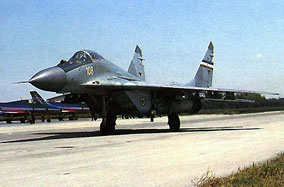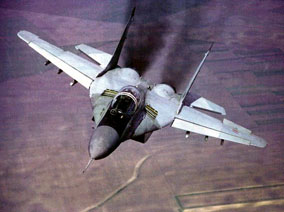The MiG-29 is a dual-role fighter optimized for the air combat role
with attack as a powerful secondary capability, and resulted from an operational
requirement issued in 1972 for an advanced fighter to replace two Mikoyan-Gurevich types
(the MiG-21 ‘Fishbed’ and MiG-23 ‘Flogger’) and two Sukhoi types (the Su-15
‘Flagon’ and Su-17 ‘Fitter’). The first of 11 MiG-29 prototypes made the type’s
initial flight in October 1977 and shortly after that time received the interim NATO
reporting name ‘Ram-L’ after it had been captured by satellite imagery at what then
thought in the West to be the Ramaneskoye test base. There were a number of engine and
aerodynamic problems, the latter requiring a fair measure of redesign, and the MiG-29
entered production only in 1982 for deliveries to service units in 1984 and an operational
debut in 1985. Despite its use of a conventional control system, the type possesses great
agility, and its employment of a low- rather than a shoulder-mounted wing should not
disguise the fact that the MiG-29 has considerably conceptual similarly to the McDonnell
Douglas F-15 in its modestly swept flying surfaces, powerplant of two widely spaced
turbofans, and tail surfaces (both horizontal and vertical) located on structural beams
extending aft on the outer sides of the engines.
 |
An unusual feature of some
note is the installation inside the engine inlets of doors that are actuated by the
extension and compression on the nosewheel leg: when the nosewheel is in contact with the
ground, the doors are closed to prevent ingestion of snow or ice as well as the
damage-causing material that often litters forward airfields, and in this regime the
engines are aspirated via louvers in the upper sides of the inlet trunks.
|
|
The initial aircraft were fitted with either an
earlier radar equipment or perhaps an underdeveloped version of the RLPK-29 Zhuk, which
offers a genuine look-down/shoot-down capability with the R-27 (AA-10 ‘Alamo’)
snap-down AAM. In its fully developed form, the Zhuk radar has a search rang of 100 km and
a tracking range of 70 km, and is linked by the fire-control and mission computers to the
laser rangefinder and IRSTS, which is located forward of the windscreen and can detect a
fighter-sized target at 15 km.
 |
The radar can track 10
targets simultaneously, but its combination with the laser rangefinder and IRSTS allows
the pilot, who wears a helmet-mounted target designator, to approach and engage targets in
electronically silent mode. The ‘Fulcrum-A’ has undergone a number of changes since it
was first seen, the consensus being that these indicate a number of fixes to bring the
design up to its present standard. The first variant was probably a pre- production model
and carried small ventral fins reminiscent of those carried by the Su-27 ‘Flanker’.
The first service model was that shown at Kuopio Risalla in Finland during July 1986, and
this model lacked the ventral fins but had provision for the dorsal fins to be extended
forward as removable overwing fences carrying IRCM flare dispensers. The third variant had
wider-chord rudders, and from 1988 became the basis of the standard type with an enlarged
dorsal spine housing either more fuel or revised electronics (possibly for the attack
role). The type is operated by the Indian Air Force with the name Baaz.
special thanks to Luka
Baturan |